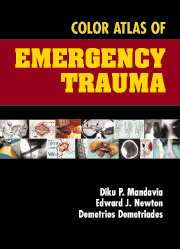3 - NECK INJURY
Published online by Cambridge University Press: 10 November 2010
Summary
Introduction
Neck injuries, especially penetrating ones, are considered difficult to evaluate and manage because of the dense concentration of so many vital structures in a small anatomical area and the difficult surgical access to many of these structures. However, very few patients with blunt trauma and only 15–20% of cases with penetrating trauma require operative treatment. The combination of a meticulous clinical examination and appropriate investigations can safely identify those patients requiring operative treatment. Advanced trauma life support (ATLS) principles should always be followed.
During the primary survey, the following life-threatening conditions in the neck should be identified and treated:
Airway obstruction due to laryngotracheal trauma or compression by external hematoma
Tension pneumothorax
Severe active bleeding, externally or in the thoracic cavity
Spinal cord injury or ischemic brain damage due to carotid artery occlusion
During the secondary survey, the following neck pathologies should be identified and managed:
Occult vascular injuries
Occult laryngotracheal injuries
Occult pharyngoesophageal injuries
Cranial or peripheral nerve injuries
Small hemopneumothoraces
Clinical Examination
Clinical examination according to a carefully written protocol is the cornerstone of the diagnosis and management. The examination should be systematic and evaluate the vessels, the aerodigestive tract, the spinal cord, the nerves, and the lungs:
Vascular structures: “Hard” signs and symptoms highly diagnostic of vascular trauma include active bleeding, shock not explained by other injuries, expanding or pulsatile hematoma, absent or significantly diminished peripheral pulses, and a bruit. “Soft” signs and symptoms suggestive but not diagnostic of vascular trauma include mild shock, moderate hematoma, and slow bleeding. This group of patients requires further investigation.
[…]
- Type
- Chapter
- Information
- Color Atlas of Emergency Trauma , pp. 57 - 82Publisher: Cambridge University PressPrint publication year: 2003



